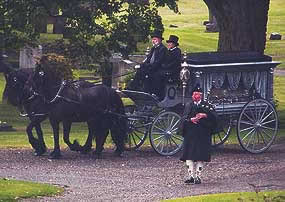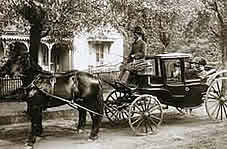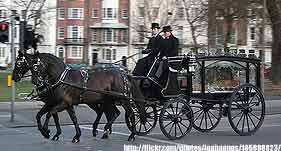
As the number of carriage companies in America grows, so do the number of Horse-Drawn Funerals. That such a thing exists in a post-industrial nation like the United States represents another paradox that can be found only in America.
A funny thing happened to me recently. While driving down the road minding my own business an “only in America” paradox sped passed. It was Joe Tetz’s funeral service truck. His burials are unique however because the horsepower that drives his hearse is literal, not figurative. He provides horse-drawn funerals in the Eastern U.S.
The need for speed, a defining characteristic of our post-industrial age, would seem to make such a thing laughable. Such funerals might appear to be just too slow and ceremonious, in a nation historically known for being in the forefront of automobile production. Yet many Americans choose this method to bury their loved ones. Their enthusiasm for such an archaic yet symbolically rich usage is yet another only in America paradox.

Tetz Coach and Hearse Company
Mr. Tetz got into this unlikely profession in an unexpected way. It all started in 1995 when some construction workers, installing a sidewalk in Bethlehem, Penn., unearthed the skeletal remains of two men in military uniforms. The buttons on their coats indicated they were Revolutionary War soldiers, so the townspeople decided to re-bury them in the grand fashion of the eighteenth century with those accompanying the flag-draped coffins wearing scarlet coats and tricorn hats. Joe and Barbara Tetz were delighted when someone asked them to provide an appropriate funeral vehicle. They owned a pair of beautiful black Friesians and were able to borrow a caisson from a friend. This was the organic beginning of Tetz Coach and Hearse Company.
A machinist by trade, Mr. Tetz eventually went on to design and build his own Victorian hearses that are some of the finest around. Since the re-burial of the soldiers in Bethlehem he has done hundreds of two-horse-power funerals.
Carriage Operators of America
Some might argue that a reenactment-style burial of Revolutionary soldiers and a hearse company in the remote hills of Eastern Pennsylvania is hardly worthy of attention. If Mr. Tetz were the only one I might agree, but he is by no means alone in his appreciation for horse-drawn funerals.
Jim and Becky Mansell are from the Chicago suburb of Peotone, Ill. In business since 1980, their website2
James Robert Massey of Princeton, N.C. is only 36 years old but has been “driving horses” since he was a boy. The inspiration for his J & L Carriage Company3 came when his sister asked him to provide a horse-drawn carriage for her wedding. Some years later, a funeral home asked if he could provide a caisson for a burial. “This may not be a bad idea,” he thought. Over the next six years he did over 100 such funerals.
This is merely a sampling of the carriage companies that exist in America. Hundreds more can be found by contacting Carriage Operators of America.4 CONA is an international organization that offers an efficient way to find a professional, high-quality carriage company that can satisfy your needs. “The most important reason for our existence” says President Tommy Doyle, “is so that this tradition is preserved.”

An American Tradition
That such a tradition continues to exist in America is quite amazing considering the initial sensation caused by the appearance of the automobile. In the beginning of the 1900’s, half the people in America had probably never even seen a car. By mid-century, over 44 million owned one.5
It wasn’t long before black limousines replaced elegant coaches and ceremonial processions were substituted by speeding motorcades. Road rage is becoming a common illness, as are the complaints from grieving family members at those who fail to pull over for passing funerals. Such comments are an indication that some Americans recognize that the seriousness of death demands more. This is one of the main reasons why some choose this type of burial.
“A horse-drawn funeral,” Mr. Mansell said, “makes a sad moment special.”
“The slow-paced, stately procession,” their website reads, “provides an opportunity for meaningful reflection prior to the farewell service.” It also diminishes the commercial aspect of burials allowing family members the extras like a graveside service and the symbolic shovel full of dirt on a lowered coffin.
 Learn All About the Prophecies of Our Lady of Good Success About Our Times
Learn All About the Prophecies of Our Lady of Good Success About Our Times
Mr. Tetz adds a unique personalized touch of window decals that appear to be etched in the glass of his hearses. The messages are as simple as “In Loving memory of…” or as poignant as “Heaven’s Hero” for a 17-year-old girl whose life was cut short. “It is the positive memory they take away with them” Mr. Tetz said, “which makes a tough day a lot easier [to handle].”
Robert Massey provided a most unique personal touch for an eight year old that lost his 41-year-old mother to a brain aneurysm.
“This one [funeral] is my momma’s,” the boy told Mr. Massey. “Do you mind if I ride back there with her?” There was just enough room for him between the casket and the side of caisson, Mr. Massey explained. The little boy draped himself across his mother’s coffin with her jacket clutched in his hands. He cried the whole way as the carriage slowly made its way to her final resting place. The grieving father walked behind carrying his three-year-old brother.
Atmosphere of Victorian Funerals
Perhaps the most important reason why Americans choose such a service is the spine-tingling sounds described so well by James Curl in his book Victorian Celebration of Death. There was a “shiver of apprehension” which preceded the appearance of the hearse in the Victorian burial processions of yesteryear.
“The rhythmical clattering of hooves,” Mr. Curl says, “and the rattle of steel-banded wheels over square-setts could be heard. As the last coach was once more enveloped, and the beating of hooves and the noise of the steel on granite receded, there was a sense of awesome desolation.”

This is the reason family members often request limousine windows be rolled down, said Mrs. Barbara Tetz. They want to hear the sounds reminiscent of a Victorian burial. This might help explain the atmosphere at the burial of Princess Diana. The tomb-like silence surrounding her funeral procession was only broken by the sounds of horses’ hooves, towing church bells and mourners’ sobs.
Recent Presidential burials have caused equal excitement. One man, after seeing President Reagan’s funeral, told Mr. Tetz, “We have to have horses also.”
Another man went so far in imitation as to request a rider-less horse with the boot turned backwards symbolizing the deceased will ride no more. Last year’s burial of Pittsburgh Mayor Bob O’Connor was another example, in a long list, of public figures transported to their final resting place with equestrian dignity.
As the number of carriage companies in America increases those witnessing such pageantry in burials are beginning to realize they too can say goodbye to family members in grand style.
* * *
This article does not imply that the horse carriage companies of America will eventually give Ford Motor company a run for their money. Nor is it meant to be a criticism of those who choose conventional means for the burial of loved ones. It merely recognizes that a segment of the American public is attracted by a type of funeral which promotes a tradition many thought was dead and is anything but consistent with the modernity for which we are known.
Although America is firmly entrenched in the twenty-first century, there are still those who appreciate the sounds, ceremonial elegance and the imponderables of a Victorian horse-drawn funeral. This century-old-way of burial is simply another example of a paradox that can be found “only in America.”
Footnotes
- Loon Meadow Farm in Norfolk, Conn. provides grieving families a distinctive burial in a “beautifully restored 1880’s glass-enclosed Hearse” which “will transport the deceased with somber elegance or grand fashion.”1http://www.loonmeadowfarm.com/otherservices.htm#funeral
- http://www.jlcarriage.com, or on Facebook at https://www.facebook.com/pg/JL-Carriage-167775549900867/about/?ref=page_internal.
- https://cona.org/about-cona/
- The Big Change by Frederick Lewis Allen, p. 6
